Great projects often start with great hopes and expectations. But if the project initiation phase isn’t successful, the project can drift off course and head for disaster. You must anchor your project at the outset by providing it with structure. Ideas are plentiful, but having a project plan and executing it allows you to actualize those hopes and ideas.
Of course, there are other project management phases, but project initiation is the first and often the most important step. With a strong project initiation phase, you’re on your way to completing the project on time and within budget.
What Is Project Initiation?
Project initiation is the first phase of a project’s life cycle. It’s at this point that the opportunity or reason for the project is identified and a project is developed to take advantage of that opportunity. It’s also during this stage when projects are approved or denied by key stakeholders, so you’ll need to conduct feasibility studies and a cost-benefit analysis to make sure the project has business value.
Project initiation is a busy project phase where you’ll need to do lots of planning and research so that your project idea turns into a reality. ProjectManager is project management software that offers multiple project views such as Gantt charts, kanban boards and project dashboards so you can keep track of risks, tasks, time and resources.
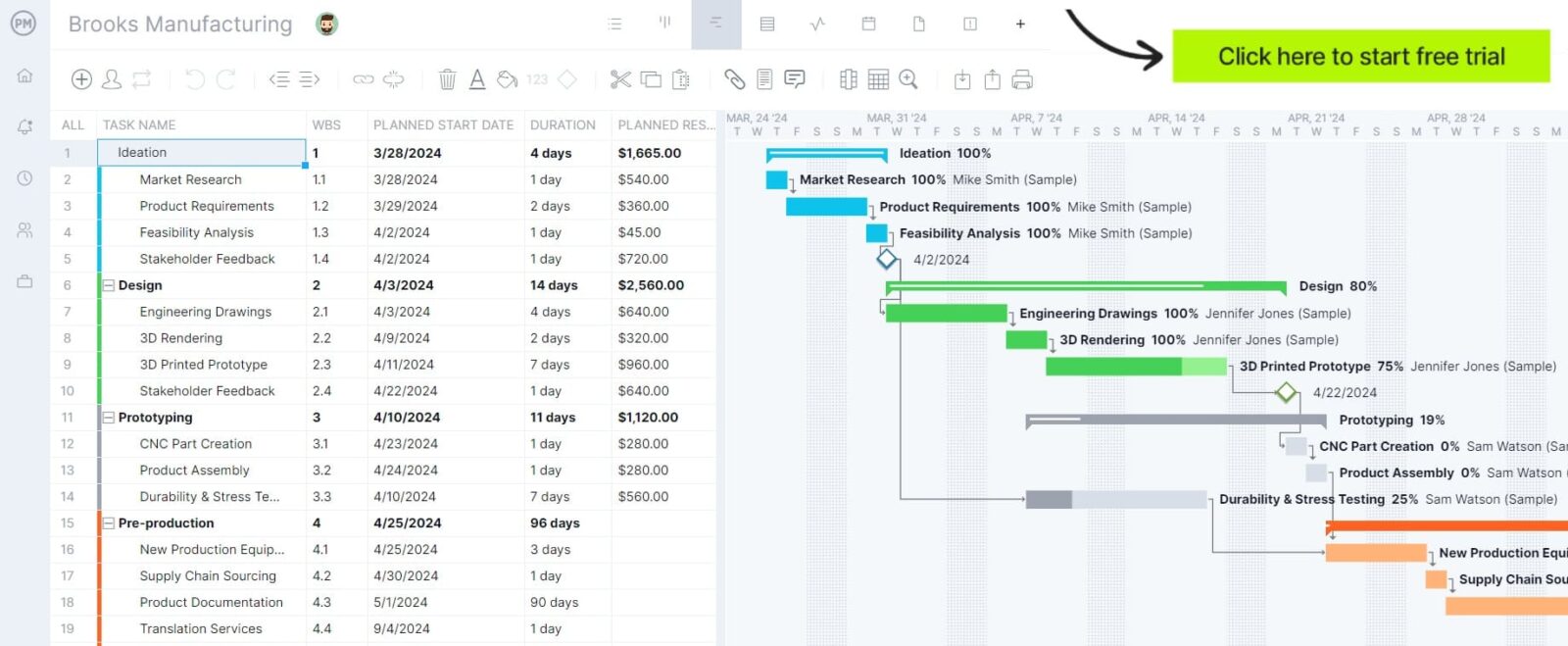
What’s the Importance of the Project Initiation Phase?
The project initiation phase is important for several reasons. The main reason is that during this stage, project sponsors assemble a project team and create project documentation to convince stakeholders of the proposed project’s value.
Project stakeholders such as the board of directors and leadership of a company will then review the project proposal, conducting a cost-benefit analysis and evaluating how it fits with other projects and programs in the project portfolio of the organization.
Once these project stakeholders decide to move forward with the project, the project manager or project management office (PMO) can continue with the project planning, project execution and project monitoring phases until the project is completed. Projects simply can’t start without a proper project management initiation phase.
Who Participates in the Project Initiation Process?
Various participants are involved in the project management initiation phase. We’ve outlined some common participants below.
Project Sponsor
Typically, the project sponsor is an executive or senior leader who oversees the project and gets its approval. They offer the needed resources including the personnel, budget and authority to kick off the project. In the project initiation process, the sponsor gets commitment from other stakeholders and acts as a liaison between top management and the project team to resolve issues and make decisions.
Project Manager
The project manager is responsible for leading the project from initiation to completion. During initiation, they will define the project objectives, scope and deliverables, working alongside stakeholders to gather requirements and coordinate resources. The project manager helps with the development of the project charter, schedule and preliminary budget while helping to identify risks.
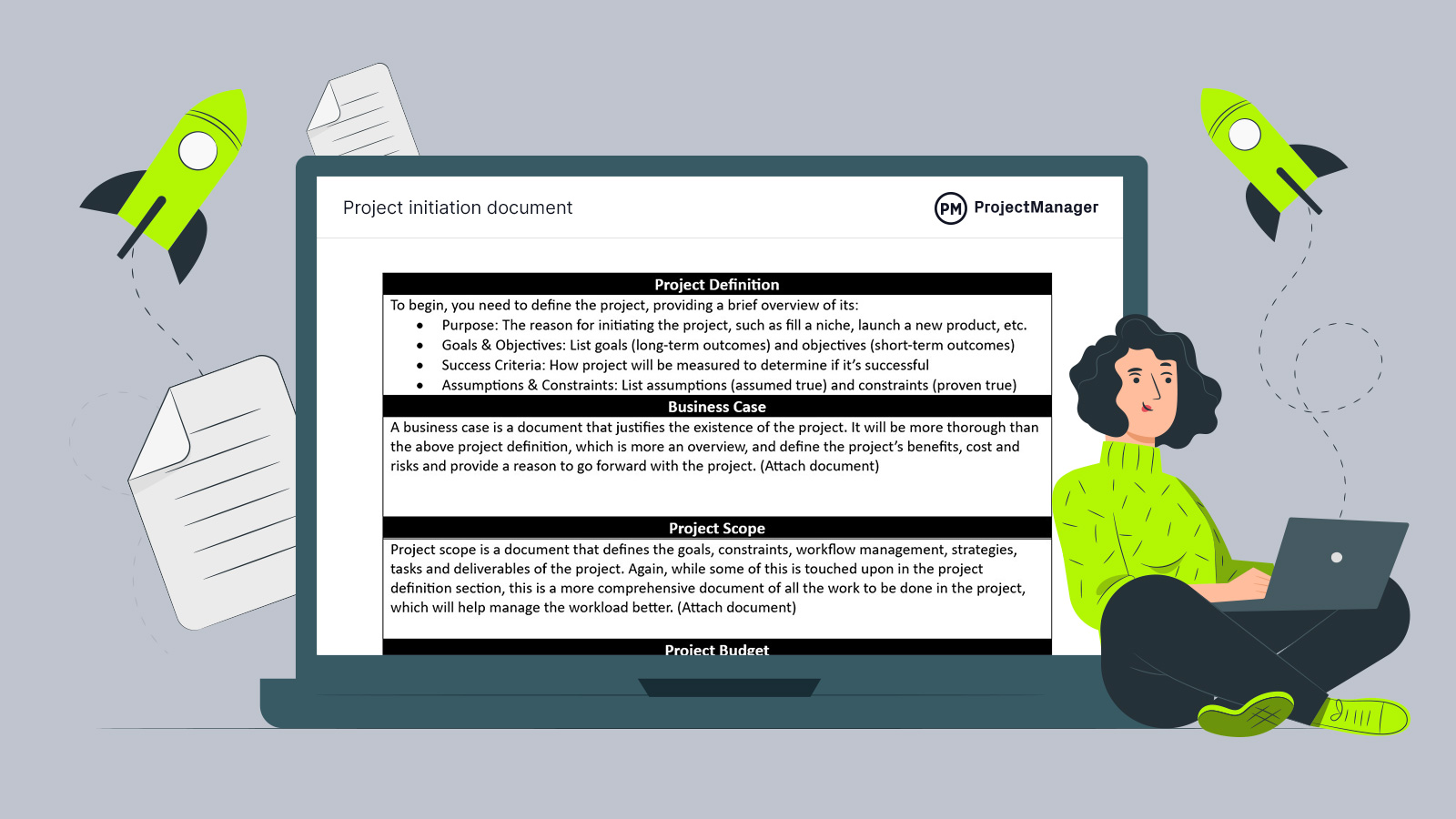
Get your free
Project Initiation Document
Use this free Project Initiation Document for Word to manage your projects better.
Project Stakeholders
Stakeholders are also involved in the project initiation process. These are individuals or groups who have a vested interest in the success of the project. They can be internal or external and include department heads, clients, end users or other business units impacted by the project. During project initiation, stakeholders will offer input on project goals, constraints and requirements to help shape the project scope and priorities.
Steering Committee
The steering committee is a group of key stakeholders or senior executives who offer high-level oversight and project direction. During initiation, they look over and approve the project’s scope, objectives and budget. The steering committee ensures that the project aligns with the organizational strategy and offers guidance on risk management and resource allocation. They are also in charge of resolving escalated issues, authorizing major changes and ensuring the project has stakeholder alignment.
Project Initiation Documentation
As mentioned, project initiation documentation helps projects move from conception to reality. Here are the most commonly used project initiation documents to help you highlight the benefits of your project and build the underpinnings of your project plan.
It’s during this phase that a team is assembled and a business case is created to define the project in detail.
Business Case
A business case is used to explain the reason for starting a project. The business case shows how the use of financial and other resources supports a business’s needs. A business case will be adaptable, fitting the size and risk of the project proposal, but it’ll structurally be the same across projects. It deals not with technical issues, but with the business concerns of the project and it needs to be comprehensive.

Ideally, the business case should be easy to understand, logical and relevant. The key aspects need to be tracked, measured and justified. There also must be accountability and commitment for the delivery and costs involved.
The structure of a business case should follow as such:
- Preface
- Table of contents
- Executive briefing, which includes what the project is, what the results of that project will be and why it should be undertaken
- An introduction explaining the business drivers, the scope of work and the financials
- Analysis with assumptions and what the costs and benefits will be, including risk
- A preliminary cost estimation, such as a rough order of magnitude
- Conclusion noting what the next steps will be
- Appendix
Project Charter
A project charter outlines the purpose of the project and how it’ll be structured and executed. In it, the vision, objectives, scope and deliverables for the project are detailed. Responsibilities for the project team and stakeholders are also described.
This next step helps to identify the project vision and objectives clearly. It defines the scope of the project and lists the deliverables.
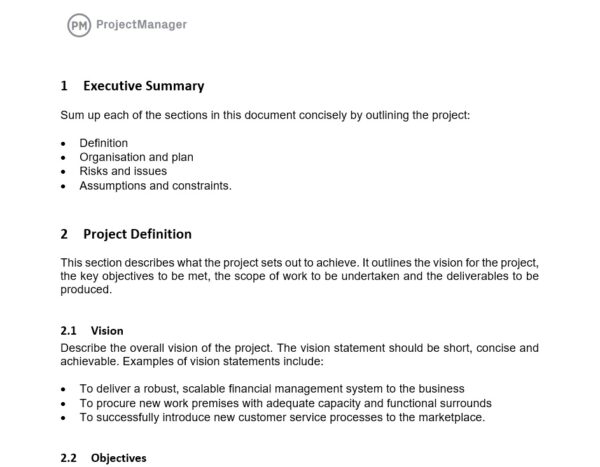
The project charter also lists the roles and responsibilities of the project team and identifies the project’s customers and stakeholders. It’s at this point that the project is organized structurally, documenting the project plan and listing all risks, issues and assumptions.
Team Charter
A team charter is similar to a project charter, only that it focuses on the roles and responsibilities of a project team. The main purpose of this document is to help teams better understand how they can work together to achieve their objectives.
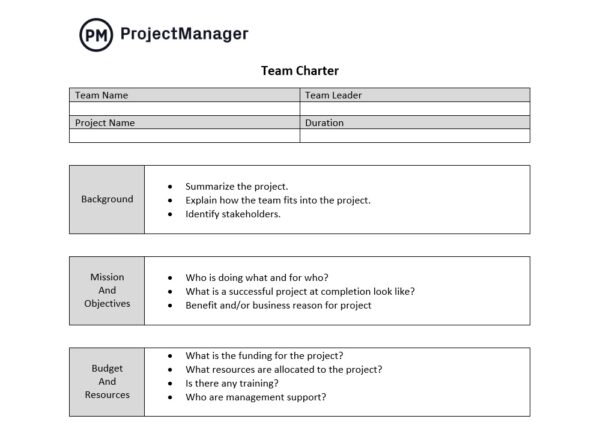
Project Initiation Document (PID)
A project initiation document is used when managing projects with a PRINCE2 framework. A project initiation document is used to define the project elements that need stakeholder approval such as the business case, scope, risks, success criteria and other important project initiation aspects.
Business Requirements Document (BRD)
The business requirements document (BRD) can be part of the project initiation phase as well. It outlines the business needs and requirements that the project is supposed to meet and acts as a formal agreement between stakeholders on what the project will deliver. This includes functional and non-functional requirements. In addition to defining the project’s scope and objectives, the BRD helps ensure alignment among the project team, stakeholders and client.
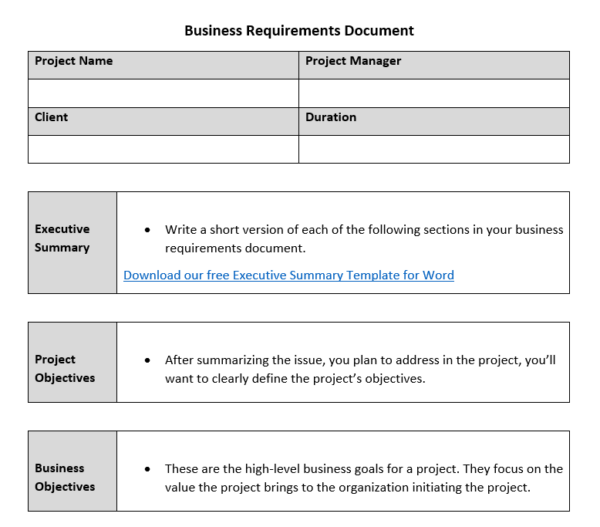
Project Brief
The project brief is one of the key project initiation documents. It’s a concise overview of the project that summarizes its scope, objectives, deliverables, timeline and stakeholders. Think of it as an initial communication tool that gives stakeholders and the project team a better understanding of the project’s goals and purpose. The project brief is usually created in the early stages of initiation to get alignment before more planning starts.

Project Proposal
Another part of project initiation documentation is the project proposal. This formal document outlines the project’s objectives, scope, timeline, estimated budget and expected outcomes. It’s typically used to gain approval or funding from clients or decision-makers. The project proposal also addresses the feasibility of the project in addition to its risks and benefits. As a result, stakeholders can assess how well it aligns with organizational goals.

Responsibility Assignment Matrix
The responsibility assignment matrix, including a RACI, DACI, RASIC and other types of responsibility assignment matrices, helps clarify project roles and responsibilities. It assigns four key categories including responsible, accountable, consulted and informed, across project tasks and deliverables. While often used during planning, it can be initiated early to define the role of stakeholders and team members to help them understand their responsibilities.
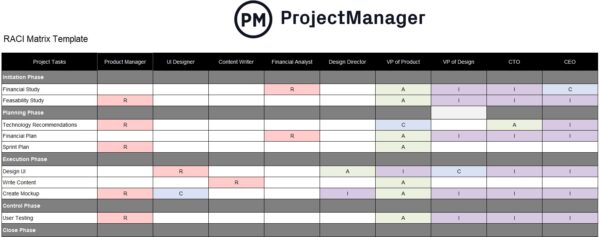
RAID Log
RAID stands for risks, assumptions, issues and decisions. The RAID log is used during project management initiation to track the aforementioned items to help project teams understand potential problems as early as possible. This allows them to develop mitigation strategies. The RAID log captures high-level risks and assumptions that could impact the project’s success in addition to any dependencies on other projects or processes.

Key Steps of the Project Initiation Phase
As stated above, the project initiation phase can be broken down into a few simple steps. Here are 5 project initiation steps to start most projects. Feel free to adjust this project initiation process to better fit your team’s needs.
1. Create Your Project Initiation Documents
As stated above, the project initiation documents are one of the main outcomes of this phase. With a project charter, business case, team charter and other supporting project documentation, you set your project up for success.
2. Conduct a Feasibility Study
Once the business case has been approved, the next step is taking a feasibility study, which documents potential solutions to the opportunity or business problem that the project is proposed to address. It directs you to the right way to approach the project.
A feasibility study researches the opportunity and documents what is required to complete a successful project. It will also identify any other solutions, if available. Project risks and issues are outlined at this time, as well as what the proposed solution to each will be if they occur.
Related: Free Feasibility Study Template for Word
3. Perform a Cost-Benefit Analysis
A cost-benefit analysis helps evaluate the project’s strengths and weaknesses. It compares the projected or estimated costs and benefits to determine if it makes sense from a business perspective. A cost-benefit analysis helps determine financial feasibility and resource allocation for informed decision-making and strategic alignment. It can also help secure stakeholder buy-in.
4. Assemble a Project Team
A project can’t be initiated without a team: this is a key part of project development. So, next comes the job descriptions for the people who will implement the project plan, including their objectives and responsibilities.
Creating a project team requires defining the roles of each member as clearly as possible to keep the work flowing smoothly. Begin by listing all the responsibilities for a position and who the person in that role will be reporting to.
Making a detailed organizational chart can help. By listing the skills and experience needed for each position, it’s easier to fill that position. It’s also helpful to note if there are any qualifications required. Of course, a performance criterion, salary and working conditions must also be defined.
5. Identify, Analyze and Prioritize Project Stakeholders
Next, identify, analyze and prioritize the stakeholders in a project. These stakeholders must be defined using a stakeholder register. Next, the stakeholder analysis uses a stakeholder matrix to determine their level of involvement, potential impact and interest. Based on this information, it’s easier to determine the most influential stakeholders on the project, resulting in the development of a stakeholder management plan.
6. Get Your Project Initiation Phase Approved
Review your project initiation documents to ensure no steps were missed before asking for stakeholder approval. It’s also important to look over the risks that have been identified and see if anything is missing. Check if your assumptions and constraints have changed before you move on to the next stage.
It’s only by starting a project right that you can end it successfully. By having a thorough project initiation phase, you clearly define the scope and build a great team to carry that project to a successful conclusion.
7. Get Your Team Ready with a Project Kickoff Meeting
After your project charter has been approved, you’ll need to have a project kickoff meeting with your project team and the project client. During this kickoff meeting, common goals and expectations will be set regarding the project scope, timeline and deliverables among other things. This guarantees a smooth transition to the project planning and execution phases.
8. Set Up the Project Management Office (PMO)
A project management office is a physical space in the office or worksite where the project manager and support staff are located during the project. It houses the communications infrastructure and whatever tech is needed for the project.
The first thing to do is figure out where the project office should be, and then make sure that the infrastructure is properly set up with the right PMO tools and equipment.
Now it’s time to outline the roles and responsibilities of those in the project office and determine the proper standards and processes. At this point, the project office can provide services to the projects and programs under its care.

Project Initiation Template
This project initiation template allows you to describe some of the most important aspects of your project, such as its business case, scope, potential risks, timeline and more. You may add more sections to it so you don’t forget any area of your project.
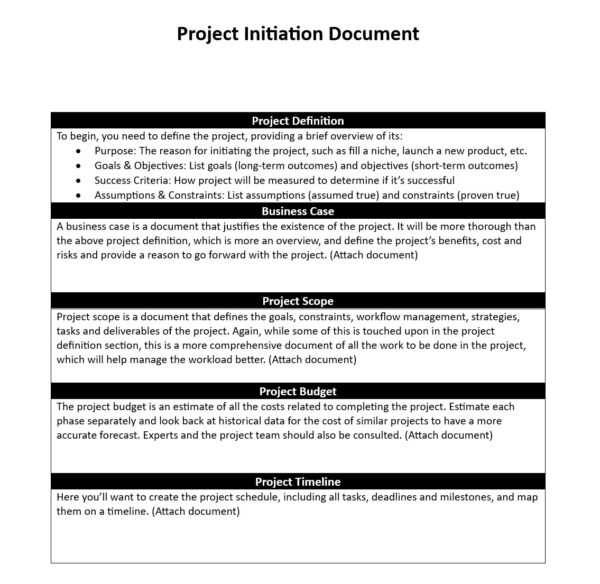
Project Management Templates to Help with the Project Initiation Phase
We’ve created dozens of project management templates to help you save time when producing your project initiation documentation. Here are a few of them.
Project Charter Template
The project charter is the initial step toward creating a fully developed project management plan. This template helps you gather important information to easily create a project charter.
Team Charter Template
A team charter helps project managers bring clarity to their team members as to how the team is structured and what their roles and responsibilities are, which is key to success in team management.
Project Roadmap Template
This project roadmap template helps you easily create a visual timeline that can be included as part of your project initiation documents. This is an easy way to quickly share your project timeline from a high-level view.
Using ProjectManager Beyond Project Initiation
Now that you’ve finished the project initiation phase, it’s time to make your project plan. Try ProjectManager, our award-winning project management software. You’ll have access to a suite of powerful tools that can help you plan, track and report on projects.
Gantt Charts for Plans
Use our online Gantt charts to transition your project from the initiation to the planning phase. Map out your tasks and link tasks that have dependencies. Set deadlines and assign tasks to team members so everyone knows their project responsibilities. You can even add comments and attachments to the tasks so team members have everything they need to get started.
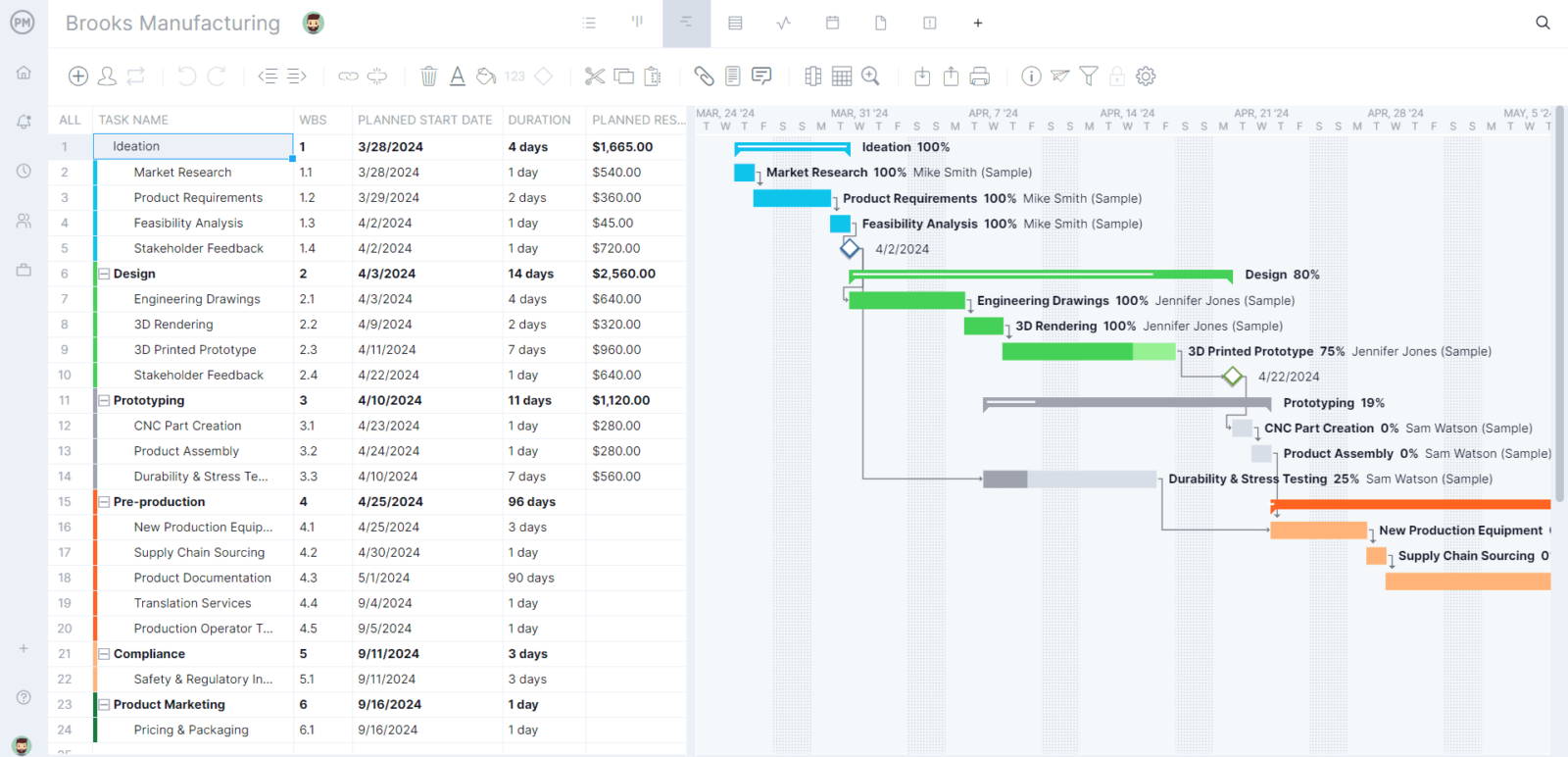
Resource Management Tools to Keep the Project on Track
If a team member is out sick or overburdened, managers even have the power to reassign tasks and redistribute workload with the click of a button with our resource management tools. These powerful features help ensure that all the work you did in the initiation phases comes to fruition.

Related Content
- Best Project Management Software for 2024
- Project Management Guide
- Project Management Process Groups: A Quick Guide
- The Triple Constraint in Project Management: Time, Scope & Cost
- The 10 Project Management Knowledge Areas (PMBOK)
- ¿Cómo Gestionar la Fase de Inicio de Un Proyecto? Guía Rápida
- Lancement de projet : comment démarrer un projet
- Projektinitiierung: So starten Sie Ihr Projekt richtig
There’s a lot to plan and monitor when initiating a project. An online project management software such as ProjectManager offers planning and tracking tools like Gantt charts, real-time dashboards and task lists to manage a project from initiation to closure. See how ProjectManager can help you with your projects by taking this free 30-day trial.

